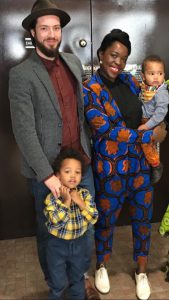We must maintain an intersectional perspective in discussions around race and racism, to better understand and reflect on the diverse realities experienced by individuals across racialised groups. In this post, Marie Skłodowska-Curie Fellow, Dr Ziada Ayorech, reflects on her experiences as a Black academic, as well as a female, and mother of two toddlers.

Dr Ziada Ayorech
The term ‘intersectionality’ was coined by Professor Kimberlé Williams Crenshaw. It refers to the many overlapping, sometimes contradicting, social categories an individual occupies – and how these contribute to their experience of discrimination and privilege. As a Black, female, mother of two toddlers, my lived experiences pursuing a career in academia can illuminate some of the challenges of bringing your full self to the workplace.
Like many moments which result in a career changing opportunity, I distinctly remember the interview that culminated in my obtaining a Research Assistant position, which subsequently turned into a PhD in Behavioural Genetics. I arrived in the SGDP lobby at King’s College London for the final interview of the day, after an Oxbridge candidate had as good as cemented the panel’s decision. The details of how I nailed the job, which was intended for my competitor, are often relayed to me by colleagues (now turned dear friends), as an example of my capacity. But like many academics, the experience of obtaining a coveted position left me with imposter syndrome.
Navigating imposter syndrome is challenging in its own right. But as a Black woman, I grappled with both the internal and the societal messages about my ability. Belonging to these two systematically oppressed categories can amplify narratives that you are lesser. Achievements which challenge that long-standing narrative are a perfect breeding ground for imposter syndrome. A shared reality of Black Indigenous and people of colour (BIPOC) is the inherent lack of representation across all spheres of our lives. From grade school, through university, to a glance at the senior faculty members at our institutions, the resounding message is loud and clear: these spaces weren’t built for you.
“Belonging to these two systematically oppressed categories can amplify narratives that you are lesser.”
The internal story I told myself (backed by personal experience of over 30 years of structural racism) was that I’d duped them: I am under qualified and any day now, the jig will be up, I will be fired. This meant that when my partner and I decided to have our first child, less than one year into my PhD, the idea of telling my supervisor that I was pregnant was almost too much to bear. Unlike so many female academics I have spoken to, I was fortunate to have an extremely compassionate supervisor, who’d seen many PhD students embark into parenthood during their degree. Despite this, I worked flat out until the birth, submitted a paper days before my maternity leave began, responded to reviewer comments weeks after my son was born, and left my 4-month-old for the first time during my maternity leave to conduct interviews. The reality for female academics who choose to pursue their careers as well as start a family is a head spinning balancing act. Have your children, but don’t let that interfere with your career. Publish at all costs, but still be at every parent-teacher meeting. Say yes always, to indicate that you are still career driven.

Ziada and her family
The challenges of navigating the demands of motherhood and academia are amplified as a Black woman. Again, intersectionality rears its ugly head. Black women in the UK are four times more likely to die in childbirth than white women (1) – a staggering statistic attributable to systemic racism in the health care system. Consistent with these statistics, the birth of my firstborn was riddled with hostile encounters at the hospital; a dangerously long labour; and eventually a traumatic emergency caesarean. I was lucky in comparison to many BIPOC mothers, who I eventually had the courage to speak with. We’d both made it home. Nonetheless, when returning to work and relaying this experience to my colleagues, I refrained from discussing the reality of structural racism at the hospital.
“I was lucky in comparison to many BIPOC mothers, who I eventually had the courage to speak with.”
Speaking up about racism can feel isolating. Repeated experiences of ‘gaslighting’ can often lead us to wonder whether we will even be believed. Additionally, Black women may internalise stereotypes such as the ‘strong black woman’; a perception that we are naturally resilient and self-sacrificing. These narratives can negatively impact mental health and reduce the likelihood to seek help. Images of motherhood are often white centred. Valid concerns about raising Black children in a racist society don’t often feature in mainstream discussions around the challenges of parenthood.
I was eight and a half months pregnant with my second born when I defended my PhD thesis, driven in part by the knowledge that I was one of the only Black female Behavioural Geneticists that I had seen at conferences, in statistics courses, at lectures, and across the many international institutions I had studied in. Letting my foot off the gas was not an option. I’ve been in conference calls where another male academic has called out his colleague for having an entirely male working group — quietly wondering to myself what would happen if I mentioned that not a single Black geneticist was pictured across the multi-centre initiative they were describing, let alone a female one.
“I was one of the only Black female Behavioural Geneticists that I had seen at conferences, in statistics courses, at lectures, and across the many international institutions I had studied in”
Open discussions about the structural racism underpinning our academic institutions, field and world are a key component of the shift of 2020. Along with the pandemic, which brought life as we know it to a standstill, came a long overdue awakening to the second pandemic affecting global citizens. As the dust settles and we emerge in 2021, how can we take an intersectional approach to our anti-racist initiatives? How can we engage in meaningful change to address the structural inequalities that, by doing nothing, we perpetuate? How can we have real lasting change?
Know your blind spots
I can speak on the Black female mother experience, because this is my reality. Other experiences, for example of ableism and transphobia, need to be brought honestly to the table if we are truly engaging in intersectionality.
Inclusivity, not just diversity
Often academic institutions describe perceived challenges in recruiting or keeping BIPOC employees. True inclusivity requires creating spaces where diversity is celebrated, welcomed and encouraged, where all voices are given a platform to wield influence. Efforts to recruit BIPOC that do not include these structural changes can be perceived as ‘tokenism’. Indeed, ‘if diversity is a sprint, inclusivity is a marathon’ (2).
Go beneath the surface
Conference surveys on whether you experienced a specific discriminative event fall short of addressing the issues at the bedrock of our institutions. Yes, I had sexist and racist comments uttered to me by senior faculty at my first genetics conference, and yes explicit codes of conduct can discourage overt discrimination — but until we use an intersectional lens to address the structural inequalities inherent in our institutions, the bandage will always fall off.
Do the work
Relying on BIPOC to lead the initiatives is disingenuous. Speaking up is risky for those who don’t hold the power. It can have a negative impact on career trajectories and wellbeing. These risks shouldn’t be left to BIPOC to take.
Change the language
Be intentional about the language you use and consider how it may perpetuate narratives (see our previous blog on this here)
The road to building new institutions that reflect our global diversity will be a long one. Engaging in honest and frank discussions about the structures that perpetuate inequality require intersectionality. It is only by considering the multitude of identities that can intersect and amplify discrimination that we can begin to create a space where each of us feel empowered to lead with our full selves.
(2) Quoted from Dana Browlee, Forbes senior contributor and Author of ‘The dangers of mistaking diversity for inclusion in the workplace’)
